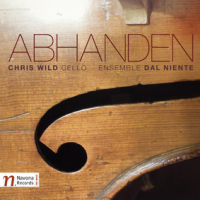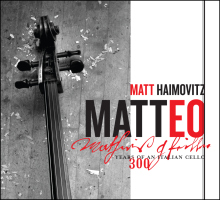String Theory 11: Cellos Mostly
|
Grant Chu Covell [October 2014.]
“Vita.” Claudio MONTEVERDI: Excerpts from Madrigals, Book VII (1619; arr. Sonia WIEDER-ATHERTON), Book VIII (1638; arr. Sonia WIEDER-ATHERTON and Franck KRAWCZYK) and L’Incoronazione di Poppea (1642; arr. Sonia WIEDER-ATHERTON and Franck KRAWCZYK): Avoce sola from Se i languidi miei sguardi; Ardo; Mentre vaga Angioletta; Introduction from Non morir Senequa; Altri canti d’amor; Hor ch’el Ciel e la Terra; Il combattimento di Tancredi e Clorinda. Giacinto SCELSI: Excerpts from Trilogy – Les Trois âges de l’homme: Triphon II, Triphon III, Dithome, Ygghur I (1956-65). Sonia Wieder-Atherton, Sarah Iancu, Matthieu Lejeune (vlc). Naïve V 5257 (1 CD) (http://www.naive.fr/). Monteverdi and Scelsi are well paired. Both could infuse a line, vocal or otherwise, with mysticism or elemental passion and create impetuous and visceral statements. Scelsi rarely follows tonal rules, and while Monteverdi does, his daring cadences startled in the early 17th century. Eleven tracks interweave the three-cello Monteverdi arrangements with parts of Scelsi’s solo Trilogy, “The Three Ages of Man.” Wieder-Atherton could be a novelist if not a musician. She has provided a story which shifts between the 17th and 20th centuries about a woman and man in love. The couples aren’t meant to intersect, except that their experiences are universal (the English-language translation wrongly reports otherwise).
“Music for cello.” Morton FELDMAN: Two Pieces (1948)1; Projection 1 (1950)2; Four Songs to Poems by e.e. cummings (1951)3; Intersection 4 (1953)4; Two Instruments (1958)5; Durations 2 (1960)6; Voices and Cello (1973)7; Patterns in a Chromatic Field (1981)8. Marco Simonacci1,2,3,4,5,6,7,8 (vlc), Giancarlo Simonacci1,3,6,8 (pno), Paola Ronchetti3,7, Ilaria Severo7 (sop), Fabio Frapparelli5 (hn). Brilliant Classics 9401 (2 CDs) (http://www.brilliantclassics.com/). Simonacci is a vibrant Feldman player. The program is arranged chronologically with the 25:14 + 64:04 Patterns in a Chromatic Field commencing at the end of the first disc. The unpublished Two Pieces come from his days working (more like arguing) with Wolpe. The cello entrants in the Projections and Intersections series are graphic scores, here played with winsome expressivity. The chronology luckily intersperses the tiny duet, Two Instruments, for horn and cello, and the strange trio, Voices and Cello, for two female voices and cello, among solo works. Patterns in a Chromatic Field is a fine introduction to Feldman’s long pieces. Throughout the cello and piano become unmoored, then stuck on ideas and phrases. The work is chromatic but not dissonant.
“Abhanden.” Chinary UNG: Spiral (1987)a. Claude VIVIER: Pièce pour violoncello et piano (1975)b. Daniel DEHAAN: If it encounters the animal, if it becomes animalized. Andrew GREENWALD: Jeku (II) (2011)c. Marcos BALTER: Memória (2007). Eliza BROWN: Ich bin der Welt abhanden gekommen (2012, rev. 2013)d. Chris Wild (vlc), Dal Niente: Mabel Kwana,b (pno), Greg Beyera (perc), J. Austin Wullimanc (vln), Amana DeBoer Bartlettd (sop). Navona Records NV5940 (1 CD) (http://www.navonarecords.com/). Wild brings his cello and a modern sensibility to a varied program. The longer pieces are less successful even as they reveal Wild’s command. Ung offers appealing timbres, but at 14:37, Spiral for cello, piano and percussion wanders. Similarly, Dehaan’s intriguingly titled solo chaotically explores extended technique without apparent goals for near to a dozen minutes. Thankfully, the inscrutable Vivier was programmed between. The short cello and piano piece sets a high standard as it wrestles with dynamic contrasts. Strangely, but appropriately, I hear organization that hints at Stockhausen, perhaps guiding structure beneath this violent duo. Grating noises appear in Greenwald’s violin and cello duo. I imagined a deteriorating clock, explicitly suggested by a long stretch of mechanical clicks. The title piece for soprano, cello and electronic sound explores a text made famous by Mahler. Uncomfortable static emerges at the periphery among distorted bits of Mahler’s original.
“Fractured Traces.” Douglas KNEHANS: spin (1996)1; night chains (1991)2; Une seule femme endormie (1991)3; night canticle (1995)4; soar (2005)5. Jiří Hošek1, Jeffrey Krieger2,4, Paul York3, Christan Wojtowicz5 (vlc), Susan Narucki3 (sop), Douglas Knehans1 (computer), Arabella Teniswood-Harvey5 (piano). Ablaze Records ar-00003 (1 CD) (http://www.ablazerecords.net/). When is a cello not a cello? Knehans pushes boundaries. For spin the live performer may arrange accompanying electronic sections to create a variably paced performance. Here we have Knehans at the controls in the 2000 Prague premiere. Night chains requires differently tuned electric cello and electronics. Frequently the electronics loop the live performer. The cello gets to live out its electric guitar fantasies. Night canticle uses similar materials as night chains, adding synthesizer and more digital effects for another extroverted romp but at a higher timbre. In the short Pierre-Jean Jouve setting, Une seule femme endormie, the cellist vocalizes pedal tones while accompanying the soprano. The latest work, soar, sans electronics, runs for a quarter-hour. Even so, despite its more traditional appearance, it’s as dynamic as the electronically infused works.
“Matteo 300.” Domenico GABRIELLI: Ricercar Nos. 1, 3, 4, 5, 6, 7 (1689). Luciano BERIO: Sequenza XIV (2002). Luigi DALLAPICCOLA: Ciaccona, Intermezzo e Adagio (1945). Brian CHERNEY: Capriccio (2010). Salvatore SCIARRINO: Ai limiti della notte (1979). Claudio AMBROSINI: Il suono e il suo doppio (2004). Matt Haimovitz (vlc). Oxingale Records OX2018 (1 CD) (http://www.oxingalerecords.com/). Instrumentalists often experience a oneness with their instruments. Wood and metal become extensions of the body and psyche. It’s pleasant to speculate about an instrument’s previous intimacies: Who owned it? Where did they live? What did they play? Some players sense that their instruments have prior knowledge of certain pieces and affinities with particular styles. One Matt considers another, as Haimovitz explores music which his Matteo Goffriller cello, a Venetian product from 1710, might have played before. Perhaps the first specifically solo cello music ever published, Gabrielli’s Ricercari ground the program. The six Ricercari contain unexpected tonal twists among melodic lines and madrigal effects. Contemporary works by other Italians are scattered about. The feathery Sciarrino is most compatible with its ancestor, resisting time and place. It endures because it asserts its own world, unlike the Dallapiccola which pours new wine in old bottles and the Berio which tries too hard to be clever. Canadian composer Cherney lives under a different flag. He’s here because he wrote a piece specifically for Haimovitz and his instrument, converting the letters in their names into musical pitches.
“Music for Double Bass.” Giacinto SCELSI: Nuits (1972). Isang YUN: Für Aki I and II (1981). Iannis XENAKIS: Theraps (1976). Manfred STAHNKE: Streetmusic III (1995). Hans Werner HENZE: S. Biagio 9 Agosto ore 1207 (1977). Bent LORENTZEN: Tiefe (1993). Frank Reinecke (cbs). NEOS 11018 (1 CD) (http://www.neos-music.com/). Reinecke’s recital moves between tunes and rhapsodies, highs and lows. Scelsi’s Nuits offer two contrasts: the song-like C’est bien la nuit, which pleases immediately, and the more abstract Le réveil profound, which grinds slowly and athematically. Für Aki I and II are minuscule tunes permitting maximum expression and vocal imitation. Theraps is the largest offering, immediately aggressive with high-wire chromatic and microtonal navigation. Plucked for its entirety, Streetmusic also explores microtones, asking for pitches between notes. The soloist also must sing along, further enhancing the work’s jazziness or street-music idiom. Henze’s postcard, “a memory for solo double bass,” captures a solitary moment under afternoon heat. In Lorentzen’s Tiefe, long notes growl as they climb upwards.
Michael Jon FINK: From a Folio (2014). Derek Stein (vlc), Michael Jon Fink (pno). Cold Blue Music CB0039 (1 CD) (http://www.coldbluemusic.com/). An 18-minute suite of seven brief movements for cello and piano, excepting the central movement, Aftersong, for multiple cellos, here multi-tracked. These vignettes employ small melodic cells over minor chords. For the most part the piano moves faster than the long-lined cello. Taken as a whole, Fink provides several direct views onto an expansive yet unpopulated landscape. These could be the central statements of a larger work with faster elements which actually resolve. It’s quite haunting if you choose to dwell here.
Ambrosini, Balter, Berio, Cherney, Dallapiccola, Dehaan, E Brown, Feldman, Gabrielli, Greenwald, Henze, Knehans, Lorentzen, Monteverdi, Scelsi, Sciarrino, Stahnke, Ung, Vivier, Xenakis, Yun
[More Grant Chu Covell, String Theory]
[More
Ambrosini, Balter, Berio, Cherney, Dallapiccola, Dehaan, E Brown, Feldman, Gabrielli, Greenwald, Henze, Knehans, Lorentzen, Monteverdi, Scelsi, Sciarrino, Stahnke, Ung, Vivier, Xenakis, Yun]
[Previous Article:
Acoustic Revive’s RR-888 Schumann Resonance Generator]
[Next Article:
Used Bin Troll Tweets J.]
|






